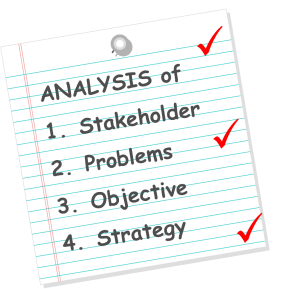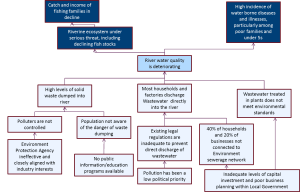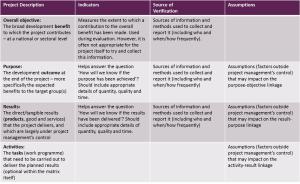Logical framework is specifically designed for development projects. It’s a structured way of linking the overall objective for the project the desired benefits, the overall purpose the results and activities. The aim is to ensure that activities completed as part of the project are clearly linked back to the overall objective of the project and the benefits that the project seeks to achieve. It provides a structured process to think through the objectives of the project based on the needs and strengths and weaknesses of the various stakeholders and parties involved in the project. It provides a step-by-step approach to working with stakeholders to understand their needs wants and ambitions and then identifying strategies which provide real benefit to the intended beneficiaries.
A step by step approach.
Logical framework provides a step-by-step approach to the planning of projects with some easily adapted tools to use at each stage. However it’s not just about the tools the application of the logical framework is about understanding the user requirements in a detailed way and working through the different options to meet those requirements using a structured decision taking process.
Analysis
The first step is analysis of the current situation. This analysis looks looks at the problem or opportunity from four different perspectives. First is a detailed analysis of the stakeholders using a stakeholder analysis template, SWOT analysis or Venn diagram showing the interaction between the different stakeholders involved in the project. For complex project this stakeholder analysis is not trivial and need to be taken seriously if the root causes of the problems (or opportunity) are to be properly identified. As with everything the logical framework is working through the process that matters and not the final output.
The next step is to understand the problem or opportunity using the root cause analysis. In this way we can identify the actionable root causes which the project could address and the consequences of the problem they were trying to fix. Again working through this problem analysis improve the understanding of the project and project team and ensures buy in of the stakeholders to the final result. Once you have full understanding the problems to be overcome this problem tree, easily translated into an objective analysis which focuses on the actions that can be taken to improve the situation.
Once have a clear understanding of the different objectives this will help us to clarify appropriate strategies for the project we can use some simple but effective tools to prioritise and rank feasibility and effectiveness of these competing strategies. From there we can then identify which are the most appropriate strategies for the project to implement.
Planning
Having defined the purpose the project and selected preferred strategy the next is to ensure that the planned activities have clear linkage back to the overall benefit that we hope to deliver. This is done by using the log frame structure the log frame structure shown below links the overall objective of the project to the activities being undertaken. The overall objective of the project is often a strategic development goal linked often to national or international standards. This is supported by the project purpose which is often more local and defines the tangible or intangible benefits to be delivered by the project. The next level down the results or the outcome of the project seeks to achieve finally the lowest level we have activities that produce deliverables as part of the project plan. The logical framework uses a clear the main clincher to make sure that if the activities are completed results are achieved if the results are achieved the purpose is achieved if the purpose is achieved in the overall outcome. This clear thinking is so often missing from projects and products are produced but no benefits are derived.
Assumptions
Key to the logical framework is the use of assumptions. It clearly identifies the assumptions that we make at each level in the objective structure. What we need to assume to be sure that they activities will produce the results that we require? What are the assumptions necessary to ensure that the results produce a purpose expected. The logical framework clearly identifies how the assumptions each level link the activities to the results of the results to the purpose and the purpose to the overall objective.
Planning
The next step is production of a project Gantt chart. This defines what activities will be done by whom and for what cost. It can also helps identify the resources and the cost the project in detail. They were back in classical project management world and you find many posts on this website about the use of effective planning.
Evaluation and monitoring
There’s an old saying that what gets measured is what gets done. To each level in logical framework we define performance measures and a mechanism to collate those performance measures. So for example we define how we going to measure the results are being achieved and that the purpose is being delivered. In this way logical framework links the activities back up to the overall objective with a clear understanding what the assumptions we make it each level and the measures that are going to be used to evaluate the project.
Delivery Monitoring and control
As with any project monitoring control is really really important. A logical framework as such doesn’t address monitoring control as it primarily focus on planning. However it is important to recognise their plan is only as good as the people who follow it. And so is important as part of a logical framework training to also address how the plan will be monitored and controlled during execution phase of the project.
Parallel Project Training courses using logical framework
As a highly experienced project management training provider ala budget training has been asked by one of his clients to integrate the logical framework into some of its courses. This is proved highly successful in helping teams understand how to apply the logical framework as part of an overall project management approach. This 2-day project management using logical framework course is now available for corporate clients from Parallel Project Training. Full details this course of our own website.

 Paul Naybour
Paul Naybour



Vey helpful.
Importance of logical frame work